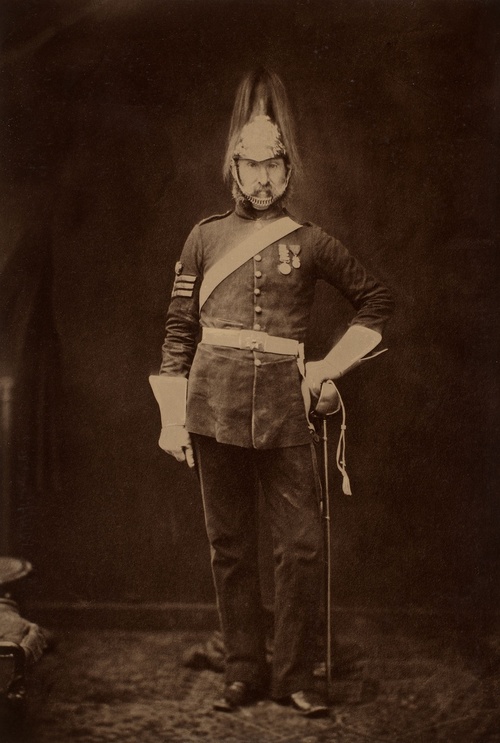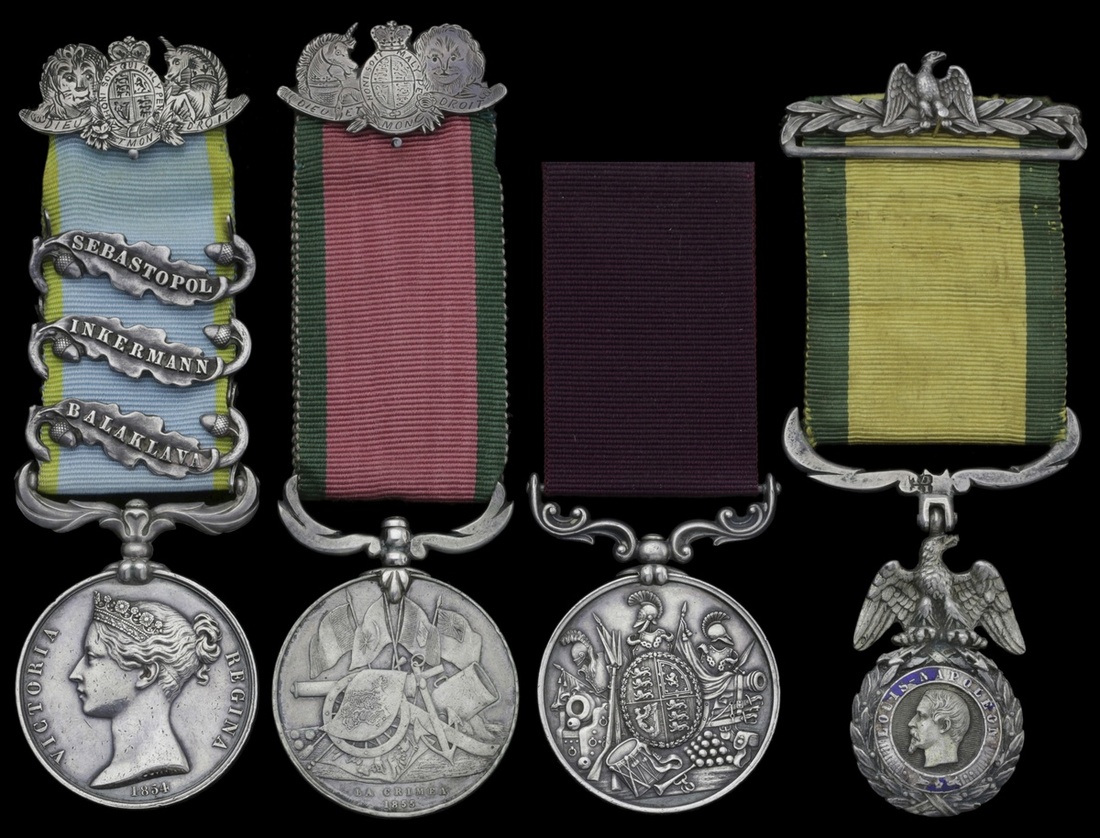Auction: 20002 - Orders, Decorations, Medals & Space Exploration
Lot: 271
The exceptional 'Heavy Brigade Charger's' Medaille Militaire group of four awarded to Troop Sergeant-Major W. F. Stewart, 5th Dragoon Guards, who had three horses killed under him in the famous engagement at Balaklava, but carried on fighting
Stewart's exploits are recorded in the journal of Troop Sergeant-Major Franks, 5th Dragoon Guards; his full-length photograph was admired by Queen Victoria, and remains part of the Royal Collection
Crimea 1854-56, 3 clasps, Balaklava, Inkermann, Sebastopol (Troop S.M. W. F. Stewart, 5th Dn. Gds.), contemporarily engraved naming, fitted with an attractive Royal Coat of Arms top riband buckle; Army L.S. & G.C., V.R. (5555 Tp.-Sjt.-Mjr. W. Steward, 5th Dragn. Gds.), large letter reverse, officially impressed naming, note surname spelling; France, Second Empire, Medaille Militaire, silver, gilt and enamel, hinge-bar suspension, fitted with an attractive French Eagle top riband buckle; Turkish Crimea 1855, Sardinian issue (No. 555 T.S.M. W. Stewart, 5th Dragoon Gds.), regimentally impressed naming, fitted with an attractive Royal Coat of Arms top riband buckle, the third with enamel loss, overall very fine and very rare (4)
Medaille Militaire:
'Troop Sergeant Major William Stewart served in the Eastern Campaign from May, 1854 until the end of the War and was present at the Battle of Balaklava, on which occasion he had two horses killed under him but still continued to act, procuring a third horse and remaining in action with his regiment. He was present at Inkermann and never absent from his duty a single day throughout the war.'
William Stewart was born circa 1814 at Perth, Scotland. Following civilian employment as a labourer, he enlisted into the 5th (Princess Charlotte of Wales's) Dragoon Guards at Glasgow on 16 November 1837, aged 23. Standing at 6 feet 1 1/4 inches tall, Stewart received a bounty of £2 - 2 - 0 on enlistment, while a further 2s - 6d was paid to the recruiting party. Assigned the regimental number 555, he served at stations across England and Ireland and was promoted to Corporal on 17 September 1847. Rising to Sergeant on 1 June 1852, he embarked with the Regiment at Queenstown on 27 May 1854, sailing to the Crimean theatre aboard the S.S. Himalaya, requisitioned by the Royal Navy from the Peninsular & Oriental Steam Navigation Company. One of the earliest screw steamers, she carried some 2,000 men to the Crimean conflict.
The Regiment arrived at Varna on 12 June 1854, and its ranks were quickly thinned by disease. The Regimental History records that by 28 August, three officers and 36 men had been lost to cholera and dysentery. At this point the commanding officer, Lieutenant-Colonel Le Marchant, had to relinquish his command and retire to England 'sick'. This left Major Adolphus Burton, with just six years' experience, in overall command of the Regiment (see Lot 372, April 2019 sale). Stewart was promoted to Troop Sergeant-Major on 1 September 1854, shortly before the landing at Kalamita Bay. He is confirmed in all the rolls as having been present at the Battle of Balaklava on 25 October 1854, taking part in the Charge of the Heavy Brigade.
This short and extremely decisive action pitted Scarlett's Heavy Brigade against some 3,000 Russian cossacks and hussars in the 'South Valley' just north of Balaklava. Led by General Rhyzov, the Russian horsemen outnumbered the British five to one and had the advantage of high ground. The British cavalry had to manoeuvre across the debris and tent pegs of the Light Brigade's hastily abandoned camp, causing severe disruption. The Heavy Brigade were badly prepared for the encounter, having been dispersed on the orders of Lord Raglan. When the Russians attacked, Scarlet found himself surrounded with just half his command. The two wings of the Russian mass began to encircle Scarlett's tiny party and all seemed lost.
At this pivotal moment, the 4th and 5th Dragoon Guards swept forward, attacking the backs of the encroaching Russian wings. The Russians were now so tightly packed as to be unable to lift their sword arms. Major Henry Clifford, Sir George Brown's A.D.C., watched events from Lord Raglan's observation post on the Sapoune Ridge. He recalled the scene:
'Like a shot from a cannon ball our brave fellows went at the astounded enemy like one man, and horses and men were seen struggling on the ground in every direction. The Russians fled in the greatest disorder, our splendid cavalry not leaving them till they had got under the protection of their artillery.'
Troop Sergeant-Major Stewart was right at the heart of the action. One of his comrades that day, Troop Sergeant-Major Franks, never forgot his bravery. In his memoirs, entitled Leaves from a Soldier's Note Book, Franks stated:
'We had a Troop Sergeant-Major named William Stewart, who had no less than three horses shot that day. The first one was by a rifle bullet. Stewart caught another horse belonging to the 4th Dragoon Guards, and he had hardly got mounted when a shell burst under him and blew him up. Stewart escaped without a scratch, and managed to catch another loose horse which he rode for a while, until a cannon ball broke the horse's leg. Stewart, who was still without a scratch, took pity on the poor dumb brute and shot him. He then procured yet another horse, which made the fourth he had ridden that day. Very few men, I should say have had such an experience as this and all within an hour.'
Faced with such heroic men as Stewart the Russians soon lost their nerve and quit the field, leaving about 270 dead. They fled to the safety of their own guns at the far end of North Valley. During their long withdrawal they were terribly exposed, and it has often been speculated what impact the British Light Brigade might have made, if Lord Lucan had seized this golden opportunity to give chase. The Charge of the Heavy Brigade lasted no more than ten minutes, and during this neat engagement the 5th Dragoon Guards lost one officer and two men killed, three officers and eight men wounded. The Heavy Brigade actually suffered more casualties later in the day, when deployed to cover the Light Brigade's retreat from the North Valley, than during the Charge of the Heavy Brigade (Pomeroy 1924, 174).
Stewart continued to serve during the Crimean campaign, and was present at the Battle of Inkermann on 5 November. He also endured the Siege of Sebastopol, finally returning home in March 1856. Shortly after this he was photographed at Aldershot by Messrs. Cundall and Howlett, proudly wearing his Crimea Medal and Turkish Crimea Medal. This photograph (illustrated) was sent directly to Queen Victoria, and it still forms part of The Royal Collection. Stewart continued to serve, though the rigours of the campaign had clearly taken their toll. He died quite unexpectedly on 28 July 1859, while on furlough at 21 Portland Street, Brighton. He had been due to receive the Medaille Militaire for his bravery at Balaklava, but this award was made posthumously in March 1861, the bestowal document bearing the pencilled remark 'dead'. His award of the Long Service & Good Conduct Medal was also made posthumously on 18 August 1859; sold together with the recipient's bestowal certificate for the Medaille Militaire, signed by the French Secretary of State for War and dated 20 March 1861, the word 'dead' scrawled in pencil at the top; another bestowal certificate for the Medaille Militaire signed by the Grand Chancellor of the Order of the Legion of Honour (dated Paris, 23 March 1861); British correspondence relating to the award of the Medaille Militaire besides copied research and extracts.
Subject to 20% VAT on Buyer’s Premium. For more information please view Terms and Conditions for Buyers.
Sold for
£4,500
Starting price
£4500







